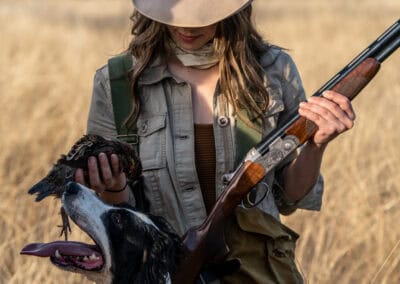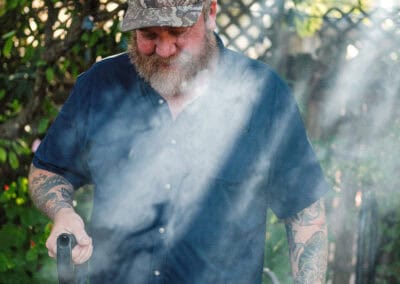Your cart is empty


Every season I drive by the Alaskan Milepost turnoff on my way to guide camp. It would only be a quick four-hour detour, yet, I have never found inspiration in the idea of traveling north to Alaska. The junction post consists of a gas station, one lone weathered sign with painted kilometer markings and a tiny dirt parking lot crammed full of motorhomes, caravans and land yachts. It is an annual cattle drive with one RV following the other, weighted with convenient comforts, satellite dishes, and electric coffee makers. A stone’s throw away, Alaska has always been there, in conversations with clients, in mile markings, in comparisons; yet, I always questioned, what could it offer that northern British Columbia did not? I live and work in God’s country, or so I thought.
It was September, and I had just finished my steelhead and salmon season on the Skeena River when I received a text with a picture of a thirty-inch Naknek rainbow trout and an open invitation. I was in the process of cleaning up this season’s gear, putting the heavy 8, 9, 10wt rods into storage, rolling up loose spools of 20lb leaders and untangling big flashy steelhead intruder flies to tuck them into their proper fly boxes. I never would have thought I would be packing all this gear back up to swing for trout, albeit giant trout in Bristol Bay, Alaska. We had put together an exploratory trip and found a small group of clients who were equally as intrigued as we were; although with cautious expectations of these adfluvial fish who mimicked their sister counterpart — anadromous steelhead.

This is a place where the tundra owns the landscape and the sound of wild water soothes your heart. Lichen, tussocks and tundra berries fill the air with a sweet sort of earthy musk, creating a cathedral for wild places and her creatures. The lodge is an old 1920’s farmhouse entirely painted in bright emerald green and decorated in Alaskan moose racks fastened above cabin doorways, taxidermied pike shovel-head mounts on the walls, whale bones rolled onto porches and other various ungulate sheds scattered throughout the grounds. It is full of Alaskan charm and character and far from a white linen experience.
We woke each morning with a small silent prayer, in hopes that the night frost did not freeze our pipes and that our seemingly-nocturnal curious bear friend was fast asleep after sniffing around our cabin doors before we walked down the icy path with our headlights to a hot cup of coffee in the main farmhouse. Everything is the same as steelheading in B.C — the gear, the swing, the step down working your soft water seams; everything is the same until someone reminds you that these are not Steelhead, but Rainbow Trout. We were a group of four from British Columbia, all with varying degrees of steelheading experience, but this was something we could not get over — how were these fish not Steelhead? They were perfect; beautifully chromed football-shaped bodies with tall shoulders, wide wrists and a faint pink stripe running along their lateral line. They took a swung fly and gave us smashing aerobatic shows, leaping up out of the currents. These were Naknek Rainbows dropping down from the lake into the river, but you would swear they were the most beautiful sea-run steelhead you have ever seen. I would have been overwhelmingly satisfied with this trip if we had stayed on the same water system, but our guide, fortunately, suggested that we fly out to Katmai National park. I’ve come across several grizzly bears in my home interior region, with only one situation that got a little western, but neither I nor the bears typically hang around for very long once spotted.

This was different though; the bears in Katmai have a social etiquette where they are able to fish and feed together in relative peace. Walking through tall tussocks of dried grasses, the brown bears blended in, naturally camouflaged against the golden blonde backdrops; which made it eerily difficult for walking. There was something that felt unnatural, and overwhelmingly wrong about walking past dozens of brown bears with no fear. I hardly fished at all, as I was completely captivated by these bears swimming like submarines all around me feeding on spawned sockeye heads and skins. Every once in a while you’d hear a heart-stopping romp through the water to see a brown bear, leaping haunches over haunches at red sockeye, and hear the crunch of breaking bones, the slurp of digestion. It was hard to fathom, standing so small, so human, watching these apex predators surrounding me — just being bears.
That sounds so simple, but it is; I think that is what is so hard for me to digest. These were wild creatures moving, feeding, sleeping and I didn’t matter. I wasn’t important to these bears, they didn’t care that I was fishing alongside them; they didn’t care when I hooked a trout and it began to jump and splash.
As a species, we often forget that humans are not always at the height of the food chain and that sometimes we are quite small comparatively.

On our way back out, I stopped to see the largest sow I’ve ever seen with two cubs sleeping at her feet. She sat watching from fifteen feet away; staring at me, and I couldn’t move yet the moment was devoid of fear. Love, serenity, stillness washed over me as tears fell down my cheeks. I wasn’t on a photography tour from a boat, I wasn’t hunting from a blind hidden away — I was in the water, navigating the same land as her and her cubs; I was with her, she was with me. It was a moment so pure and raw, that I do not know if I will ever be able to put it into words. Alaska gave me the most emotionally overwhelming wildlife experience I had ever been blessed to receive; Alaska, cathedral of the wild, you have stolen my heart.

There are not many places in the world where you can spey cast with an 8wt rod for heavy chrome Rainbow trout. This type of fishery is ideal for Spey casting as there is little room for a backcast and we seemed to have more luck with longer casts. Having a rod that will allow you to set up those long casts with little effort will help. I brought my Hardy Zephrus 13’6” 8/9wt and found that it had a fast enough action to throw those heavy Skagit style setups.
While this fishery benefits those with modern reels versus a click and pawl or a classic click check drag system, I brought my Hardy Cascapedia reel. I typically fish click and pawl when I am steelheading so I felt confident in landing fish with a click check drag.
I always bring a few lines just in case, but this time I tried the Scientific Anglers Freightliner Skagit and loved it. I rarely fish a Skagit line as I typically use longer rods (14’6” and 15’) that do not allow for such a short line, but I was really impressed with how it loaded and its smooth finish through the guides.
I had just finished my season on the Skeena River so my waders had seen better days. I didn’t have time to order new ones so I brought a bag of UV wader repair and a UV light. This didn’t work very well; each afternoon I would dump the water out of my waders and dry them out in the warm sun and put them back on for our evening session – it got pretty cold. The guides saw me dumping the water out of my waders and lent me a pair from the lodge which I was so thankful for! It was the first time trying out Redington waders and even though they were men’s waders, I quite liked them.
You are not allowed felt boots on the Naknek River, so be sure to bring vibram soles to prevent transferring any aquatic diseases.
I love my Leatherman Free T4. You can open it one-handed quickly and easily, which is different from the traditional tools. It’s been my favorite multi-tool to use on the river. The scissors are great for nippers too.
It was really cold in the mornings. My hair would be frosted over and my jacket would be pelted with frozen water droplets from the jet boat spray. I layered, layered, and layered with all the puffy jackets I could.
Related Stories



Latest Stories


